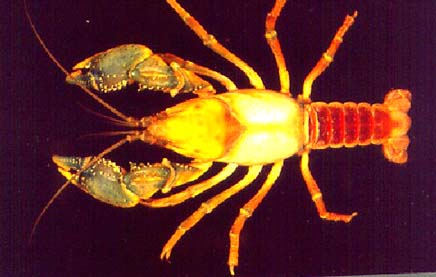Fallicambarus strawni (Reimer)
|
Recognition Characters: Rostrum lacking marginal spines with indistinct acumen. The areola is obliterated. Spines absent along surface of carapace. Antennal scale widest at midlength. Abdomen narrower than thorax and shorter than carapace. Chela strongly depressed; carapace and chela lacking conspicuous setiferous punctations. Hooks on ischiopodites of third periopods only, of male. First pleopod of Form I male terminating in three distinct processes bent at approximately a 90 degree angle to main shaft. Coloration: Dominant coloration of the carapace is pinkish cream overlain by markings of various shades of gray and vermilion. Most of the dorsum of the cephalic region is pink, fading laterally to buff with lavender suffusion. Rostrum and postorbital ridges are very dark gray. The caudal gastric area and cervical groove is pale gray. Tergum of first abdominal segment and cephalic part of second abdominal segment maroon. Terga of other segments yellowish tan, vermilion splotches dorsally. Telson largely translucent but with vermilion to brick-red splotches cephalically, laterally, and along caudal margin. Chelipeds basically tan with dense reticulations of intense dark grayish-blue dominating dorsum of distal half of merus and that of carpus. All tubercles very dark blue, almost black. Ventral surface of body cream colored. Size: Adults mature at a length of 2 to 3 inches (50-76 mm). Habitat: Hobbs (1989) presented the habitat of this primary burrowing species as burrows, both simple and complex. General Range: Arkansas endemic confined to the Saline River basin in Sevier, Howard, and Pike counties, Arkansas (Hobbs, 1989; Robison and Allen, 1995). Comments: The type locality of this primary burrowing species is a small marshy area in the Saline River drainage, 2.7 miles (4.3 km) north of Dierks, Howard County, Arkansas (Reimer, 1966). Only five specimens of this Arkansas endemic were collected from three localities within the ONF in Arkansas rendering this crayfish a rare member of the ONF crayfish fauna (Table 4). First form males have been collected in April and June. No ovigerous females have been taken; however a female from Pike County laid yellowish-orange eggs on May 17 (Hobbs, 1973). |


